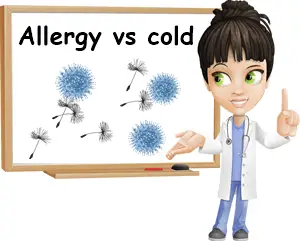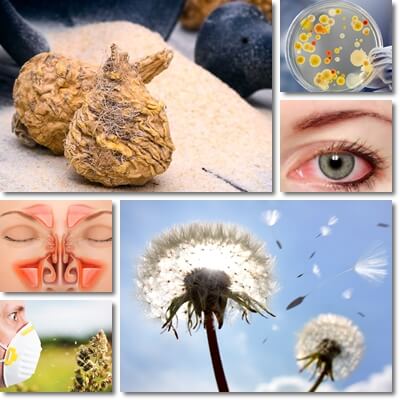It’s springtime and you have a runny nose. You’re sneezing, feeling tired and just unwell. So you wonder: is it a cold or allergies? Or is it a cold and allergies at the same time? You can actually tell the difference between a cold and allergy based on symptoms, despite the similarities between the two. Granted, it’s not always easy just as it’s not always possible to tell them apart from the beginning, but as soon as other symptoms ensue you should be able to know if it’s one or the other, or both. And here is everything you need to know to correctly distinguish between spring allergies and the common cold.
The only thing making it difficult to tell the two apart is the fact that you experience the symptoms in spring. If you were to sneeze and cough up mucus and it were winter outside, you’d have the certainty you were catching a cold. But if it’s spring and you have a history of pollen allergies, then it’s not that easy to tell if it’s allergies or a cold. What you need to remember is that the details count. Cold and allergy symptoms may be similar, but they are not exactly the same and you can actually tell which is which based on some very fine details. So how to tell if it’s allergy or a cold? This is what you should look for in terms of symptoms:

Sneezing is different
Although nothing ever applies to everyone, sneezing is an important detail to help you tell a cold and allergy apart. Sneezing in colds is common, but not frequent, nor continual and it’s not triggered by anything. So if you sneeze all of a sudden, without there being dust or pollen or you being outside, then it’s likely a cold. Not to mention it will stop after a couple of days.
Versus sneezing from a cold, sneezing from spring allergies is extremely frequent, much more than with a cold. Sneezing in the morning, especially when you open the window or go outside is a sign of spring allergies. Sneezing in sunlight also indicates a seasonal allergy because allergies cause photosensitivity, a sort of over-responsiveness to light.
Cold vs allergies mucus
The common cold typically causes a productive cough, meaning your nasal passages will produce plenty of mucus which you will expectorate via coughing, but also sneezing and as postnasal drip. As the respiratory infection progresses, the mucus is likely to turn yellow, or darker colors, which is an indication of infection.
Why is yellow or green mucus a symptom of an infection? Mucus colors other than white or white with grayish streaks indicates the presence of dead cells such as immune system cells fallen in the fight against the infection, but also virus cells that have been eliminated by the immune system and are now being removed from the body.
Find out more about what nose mucus colors mean.
With allergies, mucus is produced in even greater amounts, all the time. But the difference is it’s transparent and extremely liquid, almost watery. Allergy mucus doesn’t change color and will remain transparent or whitish at the most. In any case, it will look clear and reasonably healthy. Grey streaks can indicate the presence of inhaled dust or dirt. Mucus production also tends to increase after being outside in contact with pollen, and will continue for the duration of the pollen season.

Runny nose vs stuffy nose
It’s possible to have a bit of a runny nose at the beginning of a cold, usually occurring together with sneezing, but both are short-lived. The runny nose is usually not very pronounced and closely followed by nasal congestion as the infection progresses. A runny nose alternating with stuffiness are both characteristic of spring allergies and continual, getting worse after spending time outside in contact with plant pollen, or opening the windows to air out your home.
Tiredness and fatigue in springtime
The common cold can cause minor aches and pains and a somewhat manageable degree of tiredness. While they do not cause aches and pains, allergies can make you feel tired, exhausted even. With allergies you actually feel tired all the time for no apparent reason. Other symptoms that increase the level of fatigue include extreme sleepiness together with mental confusion or brain fogginess, and a sort of lethargy or lack of alertness. If you’re feeling tired or sleepy in spring, then it might also be spring fever which can is also frequently caused by undiagnosed seasonal pollen allergies.
Headaches
It’s uncommon to experience headaches with a common cold, although not impossible. But headaches together with sinus pressure are extremely common with spring allergies, sometimes occurring on a daily basis. It’s also possible to develop sinusitis from seasonal spring allergies due to the continual production of excessive amounts of mucus that causes stuffiness, including sinus stuffiness, and increases risks of developing an infection.
Cold vs allergic rhinitis frequency
While it may sound redundant, you have to take into account the fact that the common cold is more frequent during colder months, while allergic rhinitis is more frequent in spring, when the weather is warmer as trees and other plants need sunshine and warmth to bloom.
Other differences between cold and allergies
Symptoms specific to either seasonal allergies or the common cold include:
- Common cold: cold sensitivity, chills, occasional low-grade fever, sore throat, coughing, lack of appetite, earaches.
- Spring allergies: itchy nose, red and itchy eyes, itchy ears, itchy mouth, including itchy gums, and throat itchiness or a tingling sensation in the throat, skin itching or redness, hives, puffy eyes (more than usual if this is something you are already dealing with to a certain extent), laryngospasms, sleepiness or insomnia, lethargy, lack of motivation, foggy thinking, poor concentration, low productivity, sinus pressure, severe postnasal drip.
By addressing your symptoms and learning which are more common in which situation you can tell if it’s a spring cold or allergies. And if symptoms overlap, and they often do, consider the fine details such mucus color or what exactly triggers your sneezing. Sometimes it can be both and it’s really not that uncommon, especially if the low temperatures persist well into spring which helps with the spread of the common cold viruses.
Spring allergies and the common cold: what to do
When it comes to getting some relief, cold and allergies have different remedies and respond to different medications. Theses are some useful insights and general recommendations when dealing with the common cold vs seasonal allergies:
The common cold is caused by a virus
This means a healthy immune system will clear the infection by itself. At most, medication such as pain relievers, fever medication or nasal decongestants can help minimize symptoms. However, nasal decongestants are best avoided because they easily cause rebound congestion which increases risks of more serious side effects such as nasal decongestants addiction.
It helps to stay hydrated and eat well, especially high protein foods and foods rich in vitamin C and zinc. Taking vitamin C and zinc supplements can help strengthen the immune system, reduce common cold frequency and even ease symptoms and possibly also reduce disease length. Resting, if necessary, and it usually is, is advised.
Natural remedies such as herbal teas made from ginger, echinacea, eucalyptus, Rooibos, lemongrass, elderflower, flavored with cinnamon, cloves, lemon juice and sweetened with raw honey can help with congestion, coughing and chest discomfort. However, remember to avoid honey if you are allergic to it.
Spring allergies are an excessive immune system response
To put it into simple words, spring allergies are an overreaction of the immune system to otherwise harmless pollen particles, that is, non-pathogenic, or that do not produce disease. Limiting contact with pollen by staying indoors on windy days, showering and changing clothes as soon as you come home, drinking lots of water and having water and your essential medication with you at all times are strongly advised.
Taking vitamin C every day can help with pollen allergies as the essential nutrient is a strong natural antihistamine. Vitamin C reduces the production of histamine in the body, histamine being what causes the rashes and itching and swelling in allergic reactions. As a general rule, taking vitamin C supplements for seasonal spring allergies should start two to three weeks before the beginning of the pollen season. Overall, with both conditions it’s more of a case of preventive care and symptoms management as there is no cure for either the common cold or allergies.
